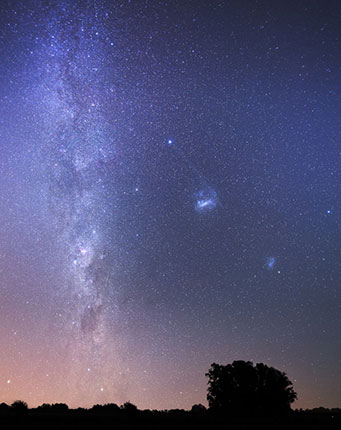
Milky Way and its two dwarf neighbors, the Small and Large Magellanic Clouds, shine in a dark night sky. The brief interloper Comet Lovejoy graces the image on its way out of the solar system.
S&T Photo Gallery: Luis Argerich
Our Milky Way Galaxy has more than a dozen known satellite galaxies. But two stand out above the crowd for their impressive size and brightness: the Large and Small Magellanic Clouds. Both are easily visible with the naked eye from the Southern Hemisphere, and have been known to skygazers since the dawn of humanity.
For decades, astronomers assumed that the Magellanic Clouds were gravitationally bound to the Milky Way, orbiting our galaxy many times over the past 10 billion or more years.
But recent Hubble Space Telescope observations strongly suggest that the Clouds have only recently been captured by our galaxy, if they have been captured at all. In the October 2012 issue of Sky & Telescope, contributing editor Robert Zimmerman discusses the past, present, and future of the Clouds, and how this recent research has completely changed our understanding of these large and impressive neighbors.
If the Clouds are only recent visitors to the Milky Way’s immediate neighborhood, then where did they come from? Watch the video below for one possible answer:
How did Milky Way manage to capture not just one, but two satellite galaxies? Simulations may hold the answer:
 0
0

Comments
You must be logged in to post a comment.